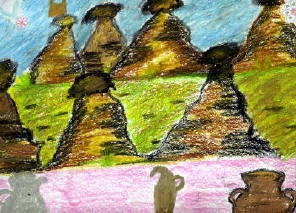|
|
|||
|
Neveshir, Cappadocia
Altinyildiz Koleji A Sufi Poem : On Children Running Through
Rumi, 13th century A Christian Monastic Rule “If a single body cannot combine with the Holy Spirit in harmony and join with others, and instead if everyone of us chose to live a life of the recluse, we could not serve the common good as God wills, but instead would satisfy our own ambitions for our pleasure.” (From the rules of Saint Basileios the Great, 329-379, founder of monasticism in Cappadocia) The Children The drawings made by the children of the Altinyildiz Koleji represent their first day’s effort in what Projectguggenheim plans to be a sustained program to connect these children with their own natural and cultural environment. These drawings are the children’s reactions to seeing a collection of Cappadocian and Turkish carpets which express their Islamic heritage and to see examples of the rock art that was left behind in the hundreds of Byzantine churches carved into the soft Tuff rock. At a time of a tragedy, when the destruction of art and monuments sacred to one culture becomes the target of hatred for others, teaching children the value of respect for other people’s art and beliefs is becoming ever more urgent. Our program will not only involve drawing, painting, and pottery making but a story-telling play that will be part of a round-the-world daisy-chain video to which children in our other programs will continue to add.
The Natural Environment The natural environment of Cappadocia was given shape by the explosion of volcanic mountains resulting in the depost of enormous quantities of both ash and molten lava over a long period of time. The ash settled and consolidated into a form of soft rock called Tuff. The Tuff maintained a white color, while the molten lava became a hard rock with deep red tones. Over time, continuous rains and wind wore down the rocks and cut them into uniquely shaped cones with capped pinnacles that have been dubbed Fairy Chimneys, among other names. The Cultural Environment and Its History The human and cultural landscape was no less dramatic. There is evidence of Paleolithic populations, as well as of Chalcolithic and Early Bronz Age cultures between 56000 B.C. and 4000 B.C., but the name Cappadocia is thought to be derived from the Persian and to mean “beautiful horses” and was first recorded in an inscription listing countries that paid tribute to Darius I (522-486 B.C.). The great Hittite empire, dated roughly between 1750 B.C. to 1180 B.C., saw a flowering of bronze-making, pottery, and the beginning of iron-making. We cannot trace here the passing of the Syrian, Roman, and Hellenistic periods when Kaisery (Caesarea) became an important center, all of which left their mark on the culture of the area and on the environment, but fast forward to Constantinus I who declared the Byzantium (later Constantinople and ultimately Istanbul) to be the seat of the Eastern Empire. Only a very small percentage of thousands of rock-carved architecture is datable to before the Christian era. A high proportion of those that survived are religious buildings, a few large ones date from the 6th to the 7th centuries. After 843, when the iconoclastic period ended, began the golden age of Cappadocian art and architecture which lasted until the arrival of the Slejuks through the 10th and first half of the 11th centuries. But under the Slejuks some construction continued, although on a smaller scale and with less elaborate construction. Non-religious architecture and art developed as well, including entire underground cities and the famous dovecotes and pigeonholes which are marked from the outside with a large range of inventive designs. Working with these designs will form a part of our program during the first year. We will also be working with the wonderful tradition of storytelling, both in words and through the weaving of carpets, that goes back to the Seljuk and Ottoman periods and still forms the basis of today’s culture. But it is necessary to keep in mind that the father of modern Turkey, decreed it a secular state in 1924. This secularism has given the country a modernity which in the end enabled it to support the U.S. in its war against terrorism in Afghanistan and other parts of the Islamic world.
|


